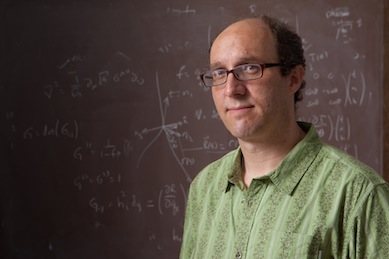A recently chosen Fulbright fellow in chemistry at the University of Houston (UH)
is hoping to accomplish something no one has done before. Among other things on professor
Eric Bittner’s wish list is to prepare a two-dimensional optical analog of a black
hole on a laser table and study some of its properties without actually having to
go to outer space to find a real one. 
“We are studying a quantum state visible to the naked eye that involves the strong
coupling between an applied laser field and organic semiconducting material sandwiched
between reflective mirrors,” Bittner said. “Such states, called polaritons, belong
to a class of particles called bosons that can exhibit a quantum collective phenomena
called Bose-Einstein condensation where the entire system collapses to a single quantum
state where everything moves in sync.”
He likens it to a mosh pit at a rock concert. When there are only a few dancers in
the pit, everyone can do their own thing and more people can be added to it without
much difficulty. If more and more people are added, there is a point where everyone
has to do the exact same motion – all in perfect sync – in order to pack in more people.
Bittner says that is what a phase transition is like, and it happens when there are
so many bosons in a given region that they have to synchronize.
“The properties of a polariton condensate are really unique and can be tuned by manipulating
the cavity and the various laser fields used to create the condensate,” he said. “In
one limit of the model, the condensate will have all the properties of a two-dimensional
black hole. Not a real one, but a ‘pseudo black hole,’ created with photons from a
laser on a lab benchtop with many analogous properties of a real black hole.”
Bittner explains that, with polaritons, these collective effects give rise to super-radiant
emission that may be useful for optical and electronic devices, such as solid-state
lasers, as well as perhaps being used in quantum cryptology, which has applications
for computer security.
Typically, Bittner says, these phenomena occur at very low, or cryogenic, temperatures.
This research will give them a chance to see these effects occurring at much higher
temperatures in non-cryogenic conditions. The goal is for scientists to potentially
study something like superconductivity in a much warmer device. In a recent paper,
the researchers showed that warming the system leads to a lower critical threshold
for condensation that, he explains, seems counterintuitive at first.
Bittner says no one, to date, has observed polariton condensation in an organic thin-film
material. His team predicts it should be possible, and Silva will be working to observe
this effect. The experiments, he says, are tricky to set up and require careful sample
preparation and state-of-the-art laser systems. Silva, an expert in ultrafast laser
spectroscopy, will be doing the experimental studies, trying to observe some of the
effects Bittner’s group predicts. They say the experimental realization could be any
day, and once they see the effect, it should be easier to set up new experiments.
“I’m hoping Silva’s group can create the condensate,” Bittner said. “It will be fun
to be on hand to see something predicted by my theory come into being. I’m sure I’ll
learn a lot about the experimental side of the work, and they’ll learn a lot of the
theory.”
Initially, Silva got Bittner interested in this topic. Silva needed some theoretical
guidance to create these systems in his lab and asked Bittner to collaborate. Bittner
received a grant from the National Science Foundation for his part of this work two
years ago.
“Before that, I had no idea what a polariton was, why they should form a condensate
or even why I should spend my time studying them,” Bittner said. “It’s a major change
of research direction for me. One of my colleagues, who is a leader in the field of
quantum dynamics, said it was extremely brave of me to step off into a totally new
field at this stage in my career. I’m happy the risk is paying off.”
Established in 1946, the Fulbright Program awards approximately 8,000 new grants annually
in more than 155 countries worldwide. An international educational exchange program
sponsored by the U.S. government, it is designed to increase mutual understanding
between the people of the United States and other countries.
###
About the University of Houston
The University of Houston is a Carnegie-designated Tier One public research university
recognized by The Princeton Review as one of the nation’s best colleges for undergraduate
education. UH serves the globally competitive Houston and Gulf Coast Region by providing
world-class faculty, experiential learning and strategic industry partnerships. Located
in the nation’s fourth-largest city, UH serves more than 39,500 students in the most
ethnically and culturally diverse region in the country. For more information about
UH, visit http://www.uh.edu/news-events/.
About the College of Natural Sciences and Mathematics
The UH College of Natural Sciences and Mathematics, with 187 ranked faculty and more
than 5,000 students, offers bachelor’s, master’s and doctoral degrees in the natural
sciences, computational sciences and mathematics. Faculty members in the departments
of biology and biochemistry, chemistry, computer science, earth and atmospheric sciences,
mathematics and physics conduct internationally recognized research in collaboration
with industry, Texas Medical Center institutions, NASA and others worldwide.
To receive UH science news via e-mail, sign up for UH-SciNews.
For additional news alerts about UH, follow us on Facebook and Twitter.